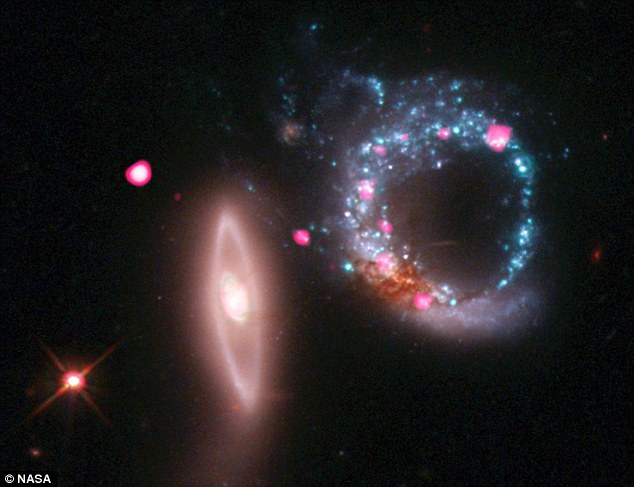But, somewhat surprisingly, the data actually shows a ring of black holes in Arp 147, a pair of interacting galaxies located 430million light years from Earth.
The composite image was taken from data collated from Nasa's Chandra X-ray Observatory and its Hubble Space Telescope.
Information gathered by Chandra is shown in pink while optical data from Hubble is red, green and blue.
Arp 147 contains the remnant of a spiral galaxy, which can be seen on the right hand side of the image, that collided with the elliptical galaxy seen on the left.
This collision has produced an expanding wave of star formation that shows up as a blue ring containing in abundance of massive young stars.
These stars race through their evolution in a few million years or less and explode as supernovas, leaving behind neutron stars and black holes.
A fraction of the neutron stars and black holes will have companion stars, and may become bright X-ray sources as they pull in matter from their companions.
The nine X-ray sources scattered around the ring in Arp 147 are so bright that they must be black holes, with masses that are likely ten to 20 times that of the sun.
An X-ray source is also detected in the nucleus of the red galaxy on the left and may be powered by a poorly-fed super-massive black hole.
This source is not obvious in the composite image but can easily be seen in the X-ray image.
Other objects unrelated to Arp 147 are also visible - a foreground star in the lower left of the image and a background quasar as the pink source above and to the left of the red galaxy.
Infrared observations with Nasa's Spitzer Space Telescope and ultraviolet observations with NASA's Galaxy Evolution Explorer have allowed estimates of the rate of star formation in the ring.
These estimates, combined with the use of models for the evolution of binary stars have allowed the authors to conclude that the most intense star formation may have ended some 15million years ago, in Earth's time frame.
These results - presented by authors Saul Rappaport, Alan Levine and Benjamin Steinhorn from the Massachusetts Institute of Technology and David Pooley from Eureka Scientific - were published in the Astrophysical Journal.




[Link]
there is a rediscovery of EU hypothesis on sott, but you still "feed it" with bs science. whys that?
(funny its named Arp [Link])